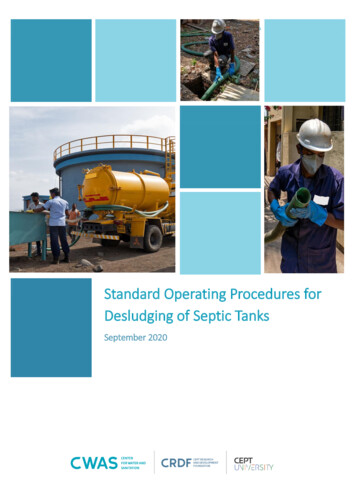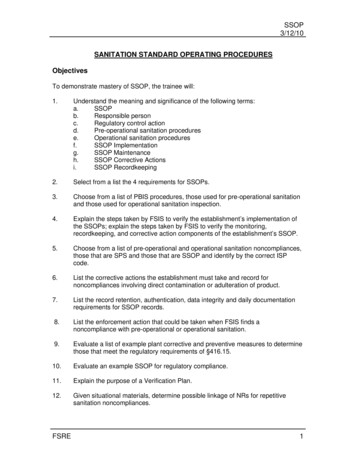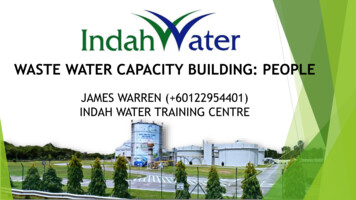
Transcription
SOP for desludging of septic tanksStandard Operating Procedures forDesludging of Septic TanksSeptember 2020
SOP for desludging of septic tanksStandard Operating Procedures forDesludging of Septic TanksCenter for Water and SanitationCRDF, CEPT UniversitySeptember 2020Citation suggestion for this document: Center for Water and Sanitation (2020) “StandardOperating Procedures for Desludging of Septic Tanks”, CWAS, CRDF, CEPT University,September 2020NoteThis document narrates a step by step procedure for desludging of septage from septic tanks and itsdisposal to the Faecal Sludge Treatment Plant. It is prepared for the desludging service provider. Thedocument is prepared using the experience of on-ground scheduled desludging operations in Wai &Sinnar in Maharashtra. It also draws on “Standard Operating Procedures for Vacuum TruckOperators for Desludging and Disposal of Septage” by WSUP1 and “Standard Operating Procedurefor cleaning of Sewers and septic tanks” by Ministry of Housing and Urban Affairs2.1WSUP (2016) “Standard Operating Procedure for Vaccum Truck Operators for Emptying and Disposal ofSeptage” USAID. GoI. SBM2CPHEEO (2018) “Standard operating procedure for cleaning sewerage and septic tanks” MoHUA. GoI
SOP for desludging of septic tanksTable of ContentsIntroduction . 5Pre-desludging Operations . 72.1.Preparing the route plan . 7During Desludging Operations . 103.1.On arrival at desludging site . 103.2.On onset of desludging operations . 113.3.At the end of desludging operations . 12Some actions for improved desludging operations: . 13Post-Desludging Operations: Disposal of Septage to Faecal Sludge Treatment Plant (FSTP) . 144.1.On arrival at treatment plant . 144.2.Discharge termination and decoupling at FSTP. 15Record Keeping and monitoring . 165.1.Record keeping of desludging services . 165.2.Actions for service improvement: . 175.3.Monitoring of desludging service . 18Precautions and Emergency Preparedness . 196.1.In event of spillage of septage . 196.2.Medical emergency . 196.3.Precautions against infections. 19Annexure I: Roles and responsibilities of individual carrying out the desludging services . 21Annexure II: Sample Questionnaire for Survey. 22Annexure III: Forms filled and submitted at various stages of desludging . 25Annexure IV: Flyers for households for awareness . 27Annexure V: Daily report of desludging operations . 29Annexure VI: SaniTab . 30Annexure VII: Geo-reference In-Out Report . 31Annexure IX: First-aid kit checklist . 32Annexure X: Protective gears and safety devices . 33Center for Water and Sanitation 3
SOP for desludging of septic tanksAnnexure XI: Basic qualifications and requirements for desludging operators . 34Annexure XII: Procedure for medical emergencies . 35List of FiguresFigure 1: Initial steps for conducting scheduled desludging . 7Figure 2 Supervisor informs households two days prior to scheduled desludging via SMS . 8Figure 3: Centralised call centre where households can request desludging services . 8Figure 4 PPE must be worn during desludging operations . 10Figure 5 Truck operator and helper lays down pumping vacuum pipe lines from the truck to theseptic tank in Wai. 10Figure 6 If the distance from the vacuum truck to the septic tank is long, two or three pipes areconnected using metal couplings. . 10Figure 7 Pump operator mixes sludge while performing desludging operations in Wai . 11Figure 8 Desludger checking 25mm sludge depth is left in the septic tank after desludging . 11Figure 9 After desludging, the cover of the septic tank must be replaced and sealed with cementplaster. . 12Figure 10 Form signed by household once the septic tank is desludged . 12Figure 11 Unloading and screening of Faecal Sludge at FSTP . 14Figure 12 Checking Inlet Quality of Septage . 14Figure 13 Record maintained at FSTP and with desludging operator. . 15Figure 14: Data from the recorded copies on a computer. . 16Figure 15: SaniTab application can be used for survey. 17Figure 16 GPS tracking system installed on trucks . 18Figure 17 A dashboard helps monitor the desludging operations. . 18Center for Water and Sanitation 4
SOP for desludging of septic tanksIntroductionIt is known that eradicating open defecation is only half the battle. For improving sanitation,faecal sludge and wastewater also needs to be safely managed. It is in this context thatGovernment of India, Ministry of Housing and Urban Affairs (MoHUA) issued a NationalFaecal Sludge and Septage Management (FSSM) Policy3 . It recommends regular desludgingof septic tanks through a systematic extraction and collection procedure which will beessential to check environmental pollution. CPHEEO suggests septic tanks should be cleanedat least once in two - three years4.In India, the common practice of desludging septic tank is that of on-call demand basedservice, i.e. septic tanks are emptied when they are full. While desludging frequencies canvary, it is typically considered a good practice to desludge septic tanks once every two tothree years, or when the tank becomes two-thirds full.Based on national and international experience, desludging practices can be grouped intotwo categories:Demand based desludging- It takes place when there is a demand from the propertyowners or users to desludge their septic tanks, typically when their septic tanks are full.Scheduled desludging- The scheduled desludging approach is essentially based on the needfor regular desludging. Under this, all septic tanks in a city are desludged once during afixed cycle. The schedule (usually three years or five years) is decided by the ULB and theservice is provided by them to the households.Scope of this document:The scope of this document is to convey knowledge to the stakeholders about the standardoperating procedures (SoPs) that need to be practiced during the desludging operation. It isto help the desludging service providers to understand and perform all activities in safemanner. Separate instructions are provided for demand based desludging and scheduledbased desludging wherever required/applicable. To simplify the process, desludgingoperations are divided into three parts: 34Pre-Desludging OperationsDuring Desludging OperationsMoUD (2017) “National Policy on Feacal Sludge and Septage Management (FSSM)” GoICPHEEO (2013) “Manual on Sewerage and Sewage Treatment Systems” Chapter. 9. MoUDCenter for Water and Sanitation 5
SOP for desludging of septic tanks Post-Desludging OperationsThis document can be helpful to Urban Local Bodies (ULBs), Public Health EngineeringDepartments and other agencies engaged in the process of desludging septic tanks acrossthe country. Further, the procedures mentioned in SOP are applicable to all serviceproviders – public or private- who employ person(s) for desludging septic tanks and theindividuals who hire such person(s) for desludging septic tanks in their premises. For ULBs, itwill also act as a guide to monitor desludging activities.Center for Water and Sanitation 6
SOP for desludging of septic tanksPre-desludging Operations2.1. Preparing the route planFor Scheduled Desludging: For scheduling emptying operations, database of households is required. This databasewill help to ascertain distance of the nearest and farthest household from the FSTP. Thisdatabase can be available from property tax database. A dedicated survey is notnecessary if required data is available with the ULBs.If needed, the survey can be conducted through mobile based tool like Sanitab. Samplequestionnaire is attached in Annexure-IBased on the information on total number of septic tanks to be emptied, requirement ofemptying trucks of various capacity (if needed) must be decided.The total cost of operations, both capital cost and operating cost, can be worked out fordesludging operations.Route planning should be prepared in consultation with the sanitary departmentofficials. Once the route plan is finalized, the IEC activities and outreach to communitiescan begin before desludging operation is initiated.FigureFigure ingscheduledscheduleddesludgingdesludgingDatabase ofHouseholdsSurveyingPaper based or OnlineULB’s propertytax dataDelineating emptying zones in the cityDecide number of trucks andcapacityRoute planningCenter for Water and Sanitation 7
SOP for desludging of septic tanks A supervisor should be appointed by the service provider for field management. He/shewill be in-charge to manage the entire scheduled desludging services. The roles andresponsibility of each individual involved in this practice is available in Annexure-1The supervisor should send bulk SMSs, two days prior to the start of the desludgingprocess as per the route plan, to household whose desludging is scheduled. The SMSinforms households about theday and time of arrival of the Figure 2 Supervisor informs households two days prior tovehicle at their property. For scheduled desludging via SMSall scheduled households, thesupervisor should send theirteam member one day prioron site. This is especiallyimportant for householdswho have not read the SMSon their mobile phones. Thesite visit will help inidentifying exact location ofseptic tanks. The house occupant must be asked to keep the covers of the septic tankopen before the team arrives for desludging. The service provider can support this byproviding a mason for opening the cover of septic tanks prior to desludging activity.The owner/mason must open the lid of the manhole and allow release of the gasespresent inside the septic tank for at least 10 to 15 minutes and make sure no one is closeto the septic tank during this time. The helper must not lean over or crouch down at thetank opening during this operationIn case the house occupant is not available on the scheduled day, their emptying shouldbe rescheduled for the next day or the day on which he/she is available and the routeplan should be altered accordingly.For Demand Desludging: The city can set-up centralised call Figure 3: Centralised call centre where householdscentre or toll-free number where can request desludging servicescitizens/households can call directlyand request for a desludging service.These can be recorded digitally.From the emptying requests receivedfor a particular day, an efficient routeplan can be developed if the thereare many requests.Center for Water and Sanitation 8
SOP for desludging of septic tanks The ULBs can either provide the emptying service through their own truck or pass onthe request to registered /licensed private operator.If demand based desludging is carried out by private operators in a city, they musteither have a contract with the ULB for desludging activity or have a license issued bythe ULB.Center for Water and Sanitation 9
SOP for desludging of septic tanksDuring Desludging Operations3.1. On arrival at desludging site On the day of desludging, the team (helpers) needsFigure 4 PPE must be worn duringto visit the scheduled households and confirm their desludging operationsavailability and readiness. They must also ensurethat the septic tank cover is open.At the outset of the desludging process, the truckoperator and helper must put on the PersonalProtective Equipment (PPE) like protective clothing,goggles, helmet, gloves etc. and make themselvesprotected from possible anticipated hazard. (ReferAnnexure-II). All equipment’s must be according tothe specifications mentioned in the Prohibition ofEmployment as Manual Scavengers and theirRehabilitation Act, 2013. It must be ensured that allthe safety equipment’s are functional and good foruse before proceeding to a septic tank.The truck operator must do a quick reconnaissance survey to identify the position ofseptic tank manhole cover and make him/herself familiar with the access route forlaying of suction hose. The tank must be inspected before and after desludging.On identifying the access, the truck operator and helpers should lay down the suctionhose from the truck to the septic tank. If the distance from vacuum truck to septic tankis long, longer pipes should be used. In absence of long pipes, two or three pipes shouldFigure 5 Truck operator and helper lays down pumping Figure 6 If the distance from the vacuum truck tovacuum pipe lines from the truck to the septic tank in the septic tank is long, two or three pipes areconnected using metal couplings.Wai.Center for Water and Sanitation 10
SOP for desludging of septic tanks be connected using metal couplings.Before starting the sludge sucking operation, the truck operator/helper must measurethe thickness of the scum layer and depth of sludge layer below the outlet tee pipe ofthe tank. This will help to estimate the amount of septage to be sucked out of the septictank. The height of sludge layer must be recorded by the truck operator/helper with thelast length of the hose pipe. Another method to record the height is by using a hard polewith markings and immersing it into the sludge to understand its level.It is essential to ensure that the suction hose is in good condition and the truck wheelsare locked during desludging operation.3.2. On onset of desludging operations Engage the vacuum equipment by using a power take-off (PTO Shaft) from the truck’stransmission;Increase the vacuum (suction pressure) to appropriate level with the valve closed bywatching the vacuum gauge, then lowering the end of the hose into the septic tank, andopen the inlet/outlet valve sufficiently such that the faecal sludge is drawn out of thetank or pit and sucked into the tanker;The truck operator must listen to the truck’s vacuum pump (for any difference in soundfrom regular) to assure that the vacuum pump is operating correctly. If the pump isblocked or jammed it will need to be cleared or repaired.During pump operation, the truck operator/helper must use the end of the hose tocontinuously break the scum layer and keep mixing the sludge with the top water layer.If necessary, long hand shovel must be used for mixing and water must be added tomake slurry of the sludge.After the sludge sucking is complete, the septic tank must be checked for remainingFigure 7 Pump operator mixes sludge while performing desludgingoperations in WaiFigure 8 Desludger checking25mm sludge depth is left in theseptic tank after desludgingCenter for Water and Sanitation 11
SOP for desludging of septic tanks sludge. If the remaining sludge is more than 25mm, excess sludge must be sucked out.25mm thickness of sludge is retained in the septic tank for allowing micro-organism tobe present inside the tank to act on the new incoming faecal waste.Identify any abnormal conditions, such as high concentration of non-biodegradablematerials, oils and grease before taking to the treatment plant for final disposal.3.3. At the end of desludging operations On completion of the desludging, the truck operator should decouple the hose byremoving the clamp fitting along the length of the hose and place the hose at correctposition in hose rack of the truck. Simultaneously, he/she must also put all theequipment in position in the hose rack.Check for spills, if any. Add disinfectants solutions such as hydrated lime to the affectedareas. Clean up any spillage using proper absorbent materials. The top of the cover andthe area around the septic tank should be sprayed with 1% chlorine solution.If the cover of the tank has been removed, it should be replaced with an easily openablecover whenever required. If desludging has been carried out through a desludging hatch,the cover of the hatch should be replaced and sealed.For daily reporting and documentation, the truck operator/helper will fill up the dailydesludging report (Annexure V) and obtain the signature of the property owner after thedesludging. One copy of this form should be handed over to household owner. (Referannexure IIIa)Figure 10 After desludging, the cover of the septictank being replaced by an easily openable coverFigure 9 Form signed by household once theseptic tank is desludged On handing over the duplicate septic tank cleaning form to the owner, the truckoperator must remove the wheel chocks and leave the premises, drive their vehicle andfollow the route plan to the designated disposal site following traffic rules. After thedisposal, the operator must visit another household as per the route plan. The vehicle helper should clean the vehicle at the end of the day to ensure that nextCenter for Water and Sanitation 12
SOP for desludging of septic tanksday’s operations start on time.Some actions for improved desludging operations: A petro card should be issued and handed over to the supervisor to ensure that the dailydesludging activity is not hampered for want of fuel.A provision of some petty cash can be made available with the supervisor to take care ofminor repairs / punctures / breakdown of vehicle so that the same do not cause delay.It is observed that a lot of time is lost during desludging of tanks at some householdbecause of non- availability of mason to open the cover. A mason can accompany thetruck operator or visit one day in advance and be paid by the household; this can helptruck operator to avoid loss of time. The ULBs can issue a letter to the service providermentioning the amount the household should pay to the mason. This will help in provingthe authenticity of collection of charges.Women must also be hired for desludging process. This facilitates discussions withhouse occupiers, on desludging operations when male members of the household arenot present.Center for Water and Sanitation 13
SOP for desludging of septic tanksPost-Desludging Operations: Disposal ofSeptage to Faecal Sludge Treatment Plant(FSTP)4.1. On arrival at treatment plant Truck operators should be received at the site entrance by the FSTP security guard.Digital record of entry of the desludging truck should be maintained by the guard throughregisters or by installing RFID (Radio Frequency Identification) systems for digitalrecording.Truck operator should discharge septage at the disposal site during its working hours andwhen FSTP operator is available to receive the septage.Once admitted inside the treatment plant premises, truck operators must follow theapproved route to the disposal location, as displayed on site through signage.Truck operator has to position the truck in the designated location (receiving point) forsludge removal, park and take the truck out of gear, apply the parking brake, and chockthe wheels.Upon arrival at the receiving point, the truck operator must meet the FSTP operator.The FSTP operator should verify the form and its information and allow the truck operatorto connect the suction hose to the FSTP receiving pipework.As a monitoring requirement, FSTP operator should check the pH (and any otherparameter if feasible) of the incoming septage for their record as required under themonitoring protocol.Figure 11 Unloading and screening of Faecal Sludgeat FSTP Figure 12 Checking Inlet Quality of SeptageBoth FSTP operator and truck operator are wearing the correct PPE such as gloves, mask,gumboot, apron and uniform etc.The pipe couplings between the truck and the receiving point should be correctly alignedCenter for Water and Sanitation 14
SOP for desludging of septic tanksto allow smooth septage flow through the pipe connection.Upon signal from the FSTP operator, the truck operator will open the tanker outlet valve,and release the septage into the inlet unit of disposal site. 4.2. Discharge termination and decoupling at FSTP The FSTP operator shall accept the entire sludge load from the desludging truck. Whenthe truck operator is certain that all septage has been discharged from the truck, he/sheshould terminate the discharge, and close the valve of the suction hose.After delivering the sludge at the plant and terminating the discharge, the truckoperator should obtain the signature of the FSTP operator and hand over copy meantfor the FSTP (Refer annexure III b) for their record and then proceed to the nexthousehold as per the route plan.Figure 13 Record maintained at FSTP and with desludging operator. The practice of washing the desludging trucks must be followed regularly to remove thesludge remains from the tank of the truck. This will help in preventing the formation ofsludge cake inside the tank affecting the performance of the truck later.It should be noted that the trucks must be washed at the FSTP location only. The sludgecoming out of tank after washing must be fed again in to the FSTP, whereas the grit andany other solids should be disposed as per the defined procedure.Center for Water and Sanitation 15
SOP for desludging of septic tanksRecord Keeping and monitoring5.1. Record keeping of desludging services After completing all trips for the day as per the route plan, the desludging truck operatorshall hand over balance 2 copies of the daily report to the supervisor and thensupervisor should handover the copy meant for the Sanitary Department of the ULB andfor the Service Providers record.The supervisor shall enter all details from the daily report in digital form (an excelformat).The final report shall also be entered in ULB’s computer database.The record keeping can also be carried out through online mobile based app like SaniTab(Annexure VI) or other. This will reduce time in collating data and analysis.The supervisor shall post summary of the daily report on the WhatsApp group which hasdesludger’s team and the ULB officials as members. This helps in keeping all themembers informed about the daily activities and ascertain whether the daily targets areachieved or not. Also, if there are issues like FSTP shutdown, vehicle breakdown,household not keeping the cover open, or any other delay, this can be postedimmediately. It will help work out a solution to the issue soon.At the end of the month, the supervisor shall submit invoice attached with copies ofdaily report signed by the sanitary officials to the account department of the ULB.Figure 14: Data from the recorded copies on a computer.Center for Water and Sanitation 16
SOP for desludging of septic tanksFigure 15: SaniTab application can be used for survey.5.2. Actions for service improvement: A monthly meeting should be held with the Chief Officer (CO) / Commissioner of the cityalong with sanitation department officials and desludging operator’s representatives.The agenda of such a meeting should be to review the performance of the previousmonth, discuss issues of the service provider, comments/ suggestions from CO /commissioner in order to improve the performance/ quality of service, delayedpayments, if any or any other relevant matter.Quarterly training should be undertaken for service provider’s staff for up-skilling. Thiswould ensure improvement in the quality of service. The training should also includelecture/demonstration on importance of use of PPEs, safety precautions to be takenwhile desludging, rules and regulations to be followed while transporting the sludge –safe driving and following traffic rules, etc.ULBs shall ensure that all desludging operation staff undergoes regular medical checkups and are administered vaccinations as appropriate.Center for Water and Sanitation 17
SOP for desludging of septic tanks5.3. Monitoring of desludging service GPS on trucks: The GPS tracking system can be installed on Figure 16 GPS trackingboth ULB desludging vehicles and private service provider’s system installed on trucksdesludging vehicles. This will help to track the movement ofdesludging trucks, services location and also ensure ULBthat collected septage is disposed only at the treatmentplant. This initiative can help improved the efficiency of thedesludging operations.Tracking and recording the data for each septic tank canenable regular/effective desludging and help createdatabase for future planning.Monitoring forms or mobile app can be developed to trackand monitor desludging operations like number of trips,volume of septage emptied, etc.Figure 17 A dashboard helps monitor the desludging operations.Center for Water and Sanitation 18
SOP for desludging of septic tanksPrecautions and Emergency Preparedness6.1. In event of spillage of septage In the event of accidental spillage of sludge/septage, the truck or FSTP operator shallimmediately take action to contain the sludge/septage, minimize the environmentalimpact, and begin clean-up procedures. The spilled sludge must be covered with limeand/ or mud and should be washed away.In case of large spillage, the operator shall notify the concerned officials about thespillage and the nature of remedial action taken within 24 hours. Penalties may beimposed on the operators who shall not comply with the guidelines.6.2. Medical emergency All the desludging operation staff must be familiarized with the emergency medical planbefore arriving at the site.A first aid kit distinctly marked with a Red Cross on white background shall be readilyavailable in the truck and FSTP site which should at least have the items as listed inAnnexure-IX.Wash up material like soap and skin cream for applying on the body shall be adequatelyavailable at the FSTP site.A list of medical care centers available may be prepared and made readily available.The truck operator shall be properly trained on the first aid and cardiopulmonaryresuscitation procedures.6.3. Precautions against infections The workers involved in the desludging operations must be educated about theimportance of wearing PPEs. Regular monitoring to be carried out by the concernedofficials from ULB to ensure that all the workers wear the PPEs during the operation atsite.The worker should be provided with a work clothes to be worn during working hours.The workers should be educated about the hazards of waterborne diseases such astyphoid, cholera through sewage and also tetanus due to cuts and wounds. Cuts andgrazes should be covered with waterproof plasters. Effective immunization of workersagainst diseases such as typhoid, cholera, tetanus, etc. should be done by vaccinationperiodically.The importance of personal hygiene should be emphasized and the worker should beinstructed to keep finger nails short and well-trimmed, wash hands with soap and hotwater before taking food and to keep fingers out of nose, mouth and eyes, because theCenter for Water and Sanitation 19
SOP for desludging of
In India, the common practice of desludging septic tank is that of on-call demand based service, i.e. septic tanks are emptied when they are full. While desludging frequencies can vary, it is typically considered a good practice to desludge septic tanks once every two to three years, or when the tank becomes two-thirds full.










